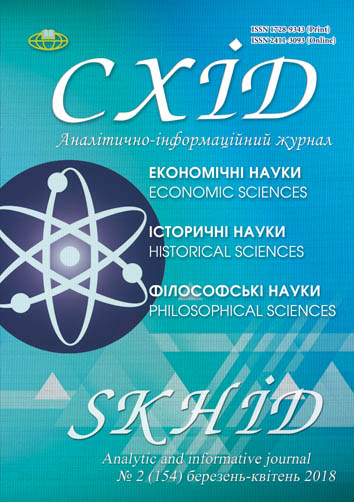Modeling of stability control of communication channels in managing the development of an industrial enterprise
DOI:
https://doi.org/10.21847/1728-9343.2018.2(154).132608Keywords:
modeling, control, stability of communication channels, management, development, industrial enterpriseAbstract
The article shows that in conditions of modern production, ensuring its efficiency and new qualitative growth in an unstable external environment, communication between people and organizations turns into a strategic resource of management. It is noted that the approaches existing in the science of science to assessing communication channels are devoted to the analysis of their actual effectiveness, while other their characteristics are not considered practically. The purpose of the article is to develop methods for formalizing estimates of the stability of communication channels of an industrial enterprise. An overview of the literature on this problem gave grounds for the classification of channels and indicators of their stability. The main types of communication flows of the enterprise in the aspect of estimation of their stability are simulated. It is proved that the main feature of the instability of the communication channel is the presence of bifurcation noise, the formula for calculating which is proposed in the paper. Also offered are scales for assessing the internal asymmetric vertical channel from subordinates to managers and from managers to subordinates. A qualitative assessment of the internal horizontal communication channel is proposed. The result of the study is the development of a scientific and methodological approach to the control of the stability of communication channels in managing the development of an industrial enterprise, the use of which enables timely detection of communication problems and the adaptation of communication channels to changes in the external environment or the features of internal communications.
References
Khoma, I.B., 2015. Decision-making control at the point of bifurcation in the process of entrepreneurial activity. Bulletin of the Lviv Polytechnic National University. Collection of scientific works. Series: «Logistics». 2015. No. 833: 103-108. Available at: http://ena.lp.edu.ua/bitstream/ntb/32903/1/16_103-108.pdf
Zozulov, O. and Poltorak, K., 2016. Kraud-technology in the management of marketing communications of the enterprise. Marketing in Ukraine. No. 4: 17-24.
Kaminsky, P.D. and Prokopenko, R.V., 2014. Information and organizational support for the management of institutional conflicts in the financial activities of industrial enterprises. Bulletin of the Donbas State Machine-Building Academy: a collection of scientific works. No. 2 (33): 214-218Kramatorsk: DDMA.
Mironova, Yu.V. and Kaglyak, O.O. and Pityk, O.V., 2016. Theoretical and theoretical bases of research of marketing communication processes at the enterprise. Bulletin of the Khmelnytsky National University. Economic sciences. No. 1: 207-214.
Molochnyk, Yu.B., 2015. Use of the system of balanced indicators for assessing the skills of employees of the communication system of enterprises. Bulletin of the National Technical University «KhPI». Series: Strategic Management, Portfolio Management, Programs and Projects. No. 2: 166-172.
Rayko, D.V., 2017. Marketing communications as a tool for information interaction between the enterprise, partners, and consumers. Marketing and digital technology. Vol. 1, No. 2: 102-122.
Sager, L.Yu., 2015. Diagnostics of the state of internal communications of an industrial enterprise: a methodical approach. Bulletin of the Sumy State University. Series: Economics. No. 3: 18-28.
Sager, L.Yu., 2017. Modeling and optimization of the process of management of internal communications of the enterprise: methodical approach. Bulletin of the Uzhgorod University. Series: Economics. Issue 2: 218-222.
Sager, L.Yu., 2013. Formation of a methodical apparatus for evaluating the effectiveness of the communication activity of an industrial enterprise. Effective economy. No. 1. Available at: http://nbuv.gov.ua/UJRN/efek_2013_1_39
Sakharova, T. V. and Filippov, M.I., 2017. Obstacles in the process of marketing communications of enterprises: causes of occurrence and ways to overcome. Actual problems of the economy. No. 6: 120-126.
Dictionary-reference terms of normative and technical documentation: Stability. Available at: https://normative_reference_dictionary.academic.ru/73786/стабильность (Accessed: 30.10.2017)
Didur, K.M., 2013. The essence of the «norm of controllability» as the main indicator of the standardization of managerial labor. Investytsiyi: praktyka ta dosvid. No. 4: 44-47. Available at: http://www.investplan.com.ua/pdf/4_2013/13.pdf (Accessed: 06.01.2018)
Shtefanych, D. and Dyachun, O., 2014. Estimation of efficiency of the communication policy of the enterprise. Bulletin of the Ternopil National University of Economics. Issue 1: 111-121.
Shcheblykina, I.O. & Shcheblykina Z.V. & Kharchenko D., 2015. Management of communication processes of modern enterprises. Collection of scientific works of the Tavria State Agrotechnological University (economic sciences). No. 1: 123-126.
Erfania, Ali & Rezaeib, Sara & Pourseific, Mehdi & Derili, Hesameldien, 2017. Optimal control in teleoperation systems with time delay: A singular perturbation approach. Journal of Computational and Applied Mathematics. Vol. 338, 15 August, Pages 168-184. DOI: 10.1016/j.cam.2018.01.026.
Wu, Jie & Zhan, Xi-Sheng & Zhang, Xian-He and all., 2017. Optimal tracking performance of networked control systems with communication delays under channel input power constraint. Transactions of the Institute of measurement and control, Vol. 39, Issue: 9: 1346. DOI: 10.1177/0142331216634831.
Downloads
Published
How to Cite
Issue
Section
License
Copyright (c) 2018 Oleksii Bezchasnyi

This work is licensed under a Creative Commons Attribution-NonCommercial-NoDerivatives 4.0 International License.
1. Authors bear responsibility for the accuracy of facts, quotations, numbers and names used.
2. Manuscripts are not sent back.
3. The publisher does not always agree with the authors' opinion.
4. The authors reserve the right to authorship of the work and pass the first publication right of this work to the journal under the terms of a Creative Commons Attribution Non-Commercial License, which allows others to freely distribute the published research with the obligatory reference to the authors of the original work and the first publication of the work in this journal.
5. The authors have the right to conclude separate supplement agreements that relate to non-exclusive work distribution in the form in which it has been published by the journal (for example, to upload the work to the online storage of the journal or publish it as part of a monograph), provided that the reference to the first publication of the work in this journal is included.

